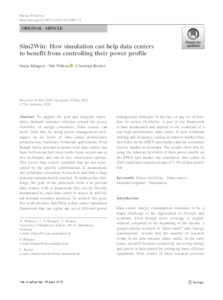|
Sim2Win: How simulation can help data centers to benefit from controlling their power profile
Klingert, Sonja
;
Wilken, Nils
;
Becker, Christian
![[img]](https://madoc.bib.uni-mannheim.de/55299/1.hassmallThumbnailVersion/Klingert2020_Article_Sim2WinHowSimulationCanHelpDat.pdf)  Vorschau |
|
PDF
Klingert2020_Article_Sim2WinHowSimulationCanHelpDat.pdf
- Veröffentlichte Version
Download (3MB)
|
|
DOI:
|
https://doi.org/10.1007/s12053-020-09873-5
|
|
URL:
|
https://madoc.bib.uni-mannheim.de/55299
|
|
Weitere URL:
|
https://link.springer.com/article/10.1007%2Fs12053...
|
|
URN:
|
urn:nbn:de:bsz:180-madoc-552999
|
|
Dokumenttyp:
|
Zeitschriftenartikel
|
|
Erscheinungsjahr:
|
2020
|
|
Titel einer Zeitschrift oder einer Reihe:
|
Energy Efficiency
|
|
Band/Volume:
|
13
|
|
Heft/Issue:
|
5
|
|
Seitenbereich:
|
1007-1029
|
|
Ort der Veröffentlichung:
|
Dordrecht [u.a.]
|
|
Verlag:
|
Springer Nature
|
|
ISSN:
|
1570-646X , 1570-6478
|
|
Sprache der Veröffentlichung:
|
Englisch
|
|
Einrichtung:
|
Außerfakultäre Einrichtungen > Institut für Enterprise Systems (InES)
Fakultät für Betriebswirtschaftslehre > Wirtschaftsinformatik II (Becker 2006-2021)
|
|
Fachgebiet:
|
004 Informatik
|
|
Abstract:
|
To support the grid and integrate renewables, demand response schemes reward the power flexibility of energy consumers. Data centers can profit from this by using power management techniques on all levels of data center architecture: infrastructure, hardware, workload, applications. Even though lately, demand response with data centers has been well researched, most works focus on just one or two techniques and one or two valorization options. This leaves data centers stranded that are not represented by the specific combinations of assumptions and techniques presented in research, and thus a huge potential remains barely touched. To address this challenge, the goal of the presented work is to provide data centers with a framework that can be flexibly instantiated by each data center to assess its individual demand response potential. To achieve this goal, this work presents Sim2Win, a data center simulation framework that can replay any set of different power management strategies in the face of any set of markets for power flexibility. A part of the framework is then instantiated and applied to the workload of a real high-performance data center. It uses workload shifting and frequency scaling in order to market their flexibility on the EPEX spot market and the secondary reserve market in Germany. The results show that by using the inherent flexibility of their power profile on the EPEX spot market the considered data center in 2014 could have earned savings of 7.3% of their power bill.
|
 
 | Dieser Eintrag ist Teil der Universitätsbibliographie. |
 | Das Dokument wird vom Publikationsserver der Universitätsbibliothek Mannheim bereitgestellt. |
 Suche Autoren in Suche Autoren in
Sie haben einen Fehler gefunden? Teilen Sie uns Ihren Korrekturwunsch bitte hier mit: E-Mail
Actions (login required)
 |
Eintrag anzeigen |
|
|
 ORCID: 0000-0003-1336-245X ; Becker, Christian
ORCID: 0000-0003-1336-245X ; Becker, Christian





 Suche Autoren in
Suche Autoren in